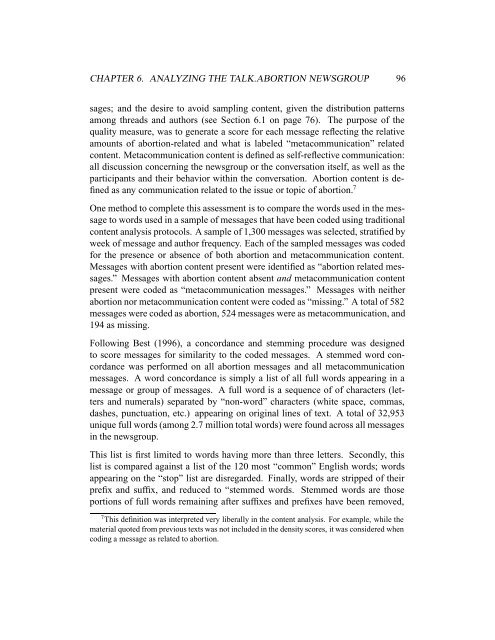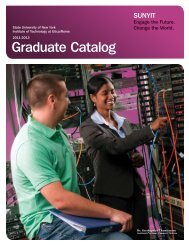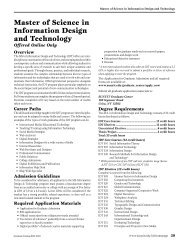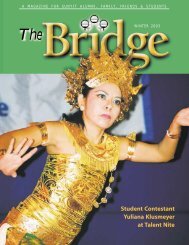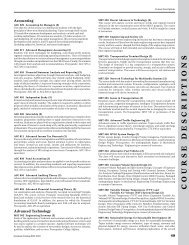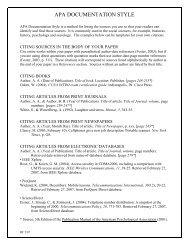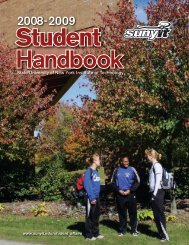Expanding the Public Sphere through Computer ... - ResearchGate
Expanding the Public Sphere through Computer ... - ResearchGate
Expanding the Public Sphere through Computer ... - ResearchGate
Create successful ePaper yourself
Turn your PDF publications into a flip-book with our unique Google optimized e-Paper software.
CHAPTER 6. ANALYZING THE TALK.ABORTION NEWSGROUP 96<br />
sages; and <strong>the</strong> desire to avoid sampling content, given <strong>the</strong> distribution patterns<br />
among threads and authors (see Section 6.1 on page 76). The purpose of <strong>the</strong><br />
quality measure, was to generate a score for each message reflecting <strong>the</strong> relative<br />
amounts of abortion-related and what is labeled “metacommunication” related<br />
content. Metacommunication content is defined as self-reflective communication:<br />
all discussion concerning <strong>the</strong> newsgroup or <strong>the</strong> conversation itself, as well as <strong>the</strong><br />
participants and <strong>the</strong>ir behavior within <strong>the</strong> conversation. Abortion content is defined<br />
as any communication related to <strong>the</strong> issue or topic of abortion. 7<br />
One method to complete this assessment is to compare <strong>the</strong> words used in <strong>the</strong> message<br />
to words used in a sample of messages that have been coded using traditional<br />
content analysis protocols. A sample of 1,300 messages was selected, stratified by<br />
week of message and author frequency. Each of <strong>the</strong> sampled messages was coded<br />
for <strong>the</strong> presence or absence of both abortion and metacommunication content.<br />
Messages with abortion content present were identified as “abortion related messages.”<br />
Messages with abortion content absent and metacommunication content<br />
present were coded as “metacommunication messages.” Messages with nei<strong>the</strong>r<br />
abortion nor metacommunication content were coded as “missing.” A total of 582<br />
messages were coded as abortion, 524 messages were as metacommunication, and<br />
194 as missing.<br />
Following Best (1996), a concordance and stemming procedure was designed<br />
to score messages for similarity to <strong>the</strong> coded messages. A stemmed word concordance<br />
was performed on all abortion messages and all metacommunication<br />
messages. A word concordance is simply a list of all full words appearing in a<br />
message or group of messages. A full word is a sequence of of characters (letters<br />
and numerals) separated by “non-word” characters (white space, commas,<br />
dashes, punctuation, etc.) appearing on original lines of text. A total of 32,953<br />
unique full words (among 2.7 million total words) were found across all messages<br />
in <strong>the</strong> newsgroup.<br />
This list is first limited to words having more than three letters. Secondly, this<br />
list is compared against a list of <strong>the</strong> 120 most “common” English words; words<br />
appearing on <strong>the</strong> “stop” list are disregarded. Finally, words are stripped of <strong>the</strong>ir<br />
prefix and suffix, and reduced to “stemmed words. Stemmed words are those<br />
portions of full words remaining after suffixes and prefixes have been removed,<br />
7 This definition was interpreted very liberally in <strong>the</strong> content analysis. For example, while <strong>the</strong><br />
material quoted from previous texts was not included in <strong>the</strong> density scores, it was considered when<br />
coding a message as related to abortion.


